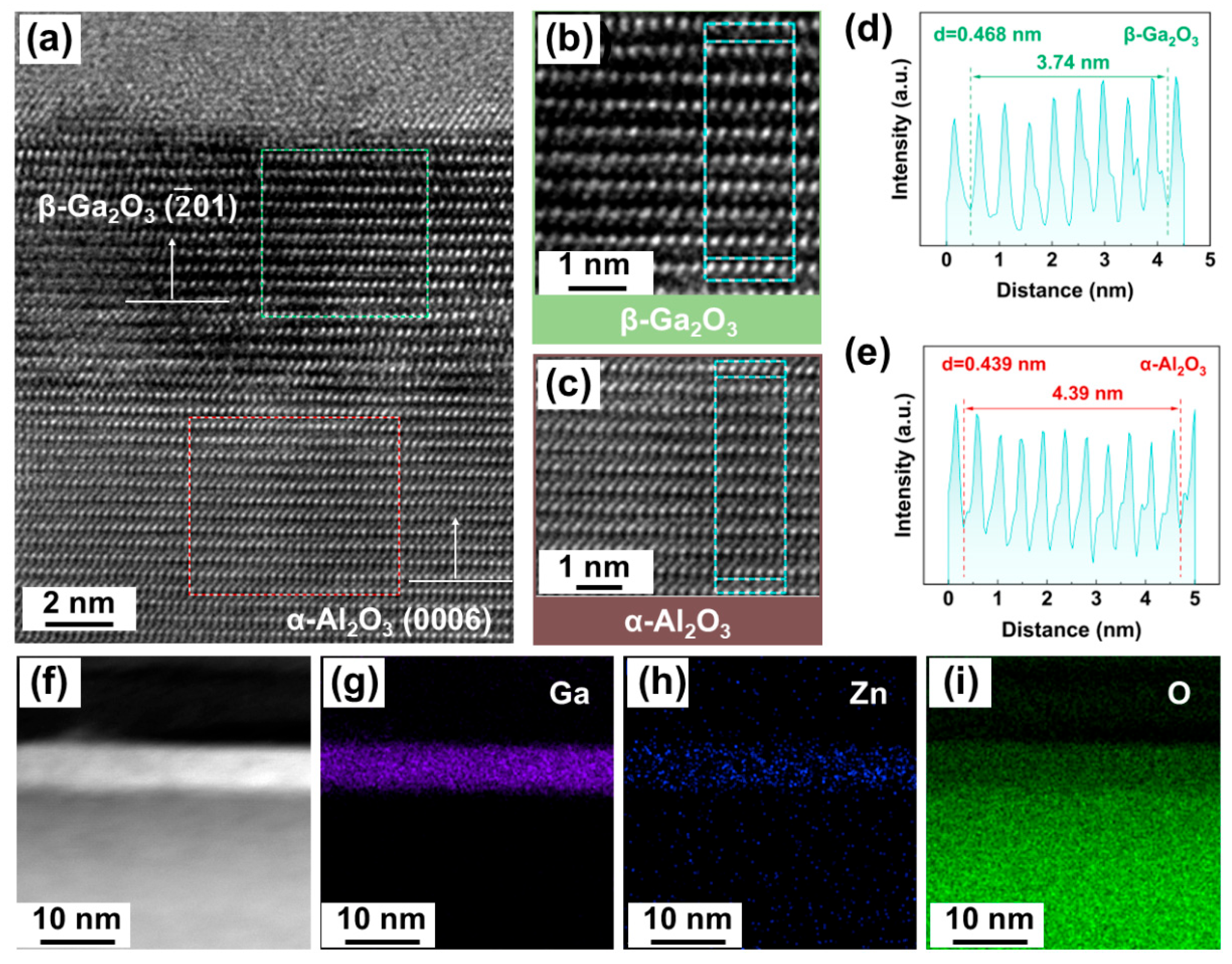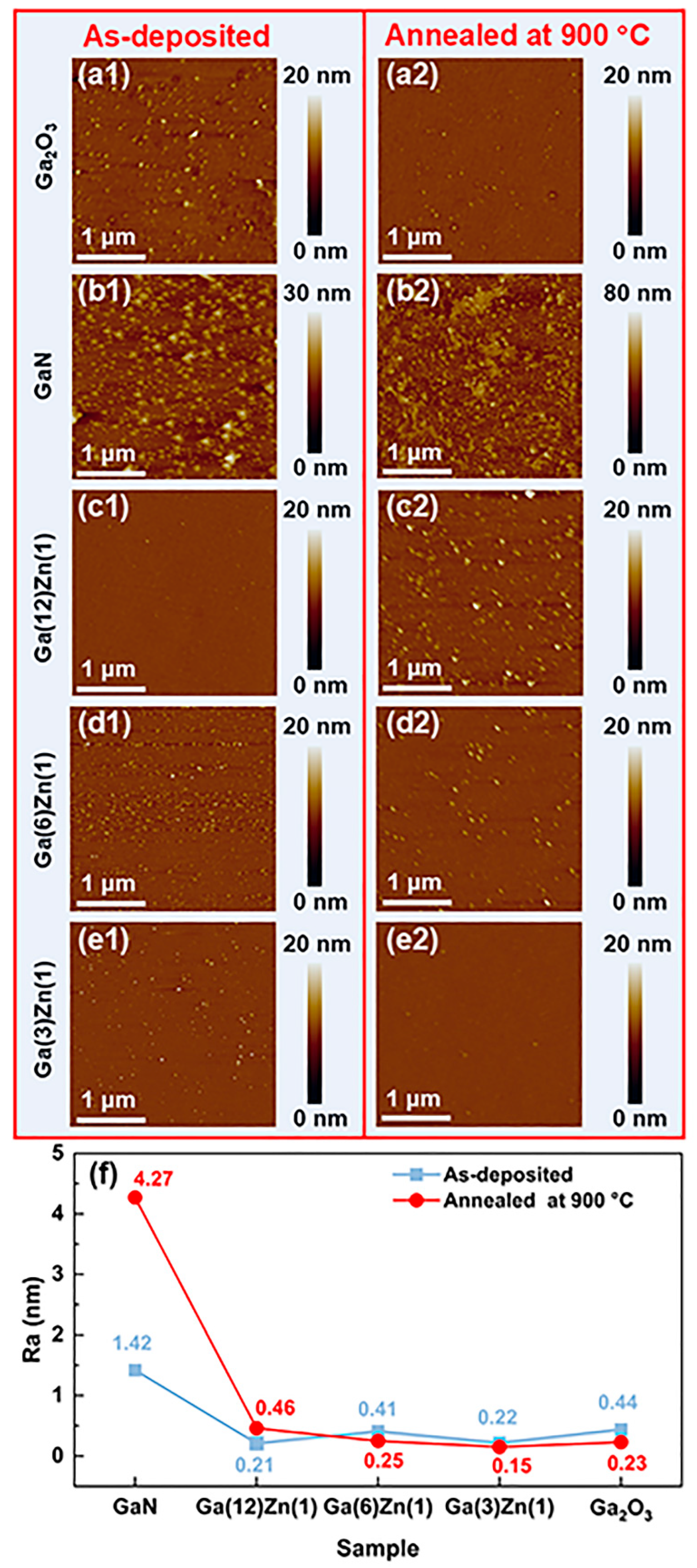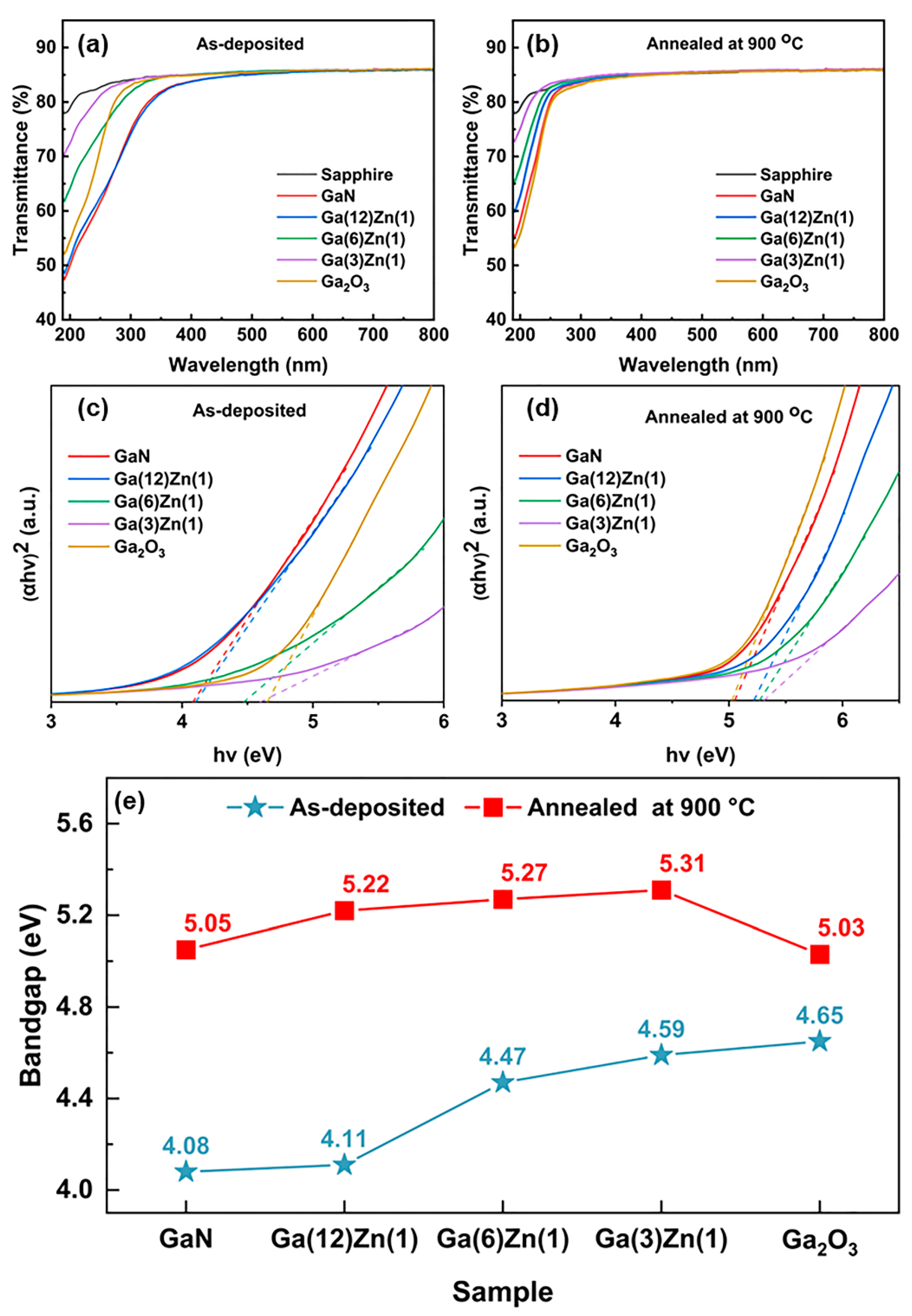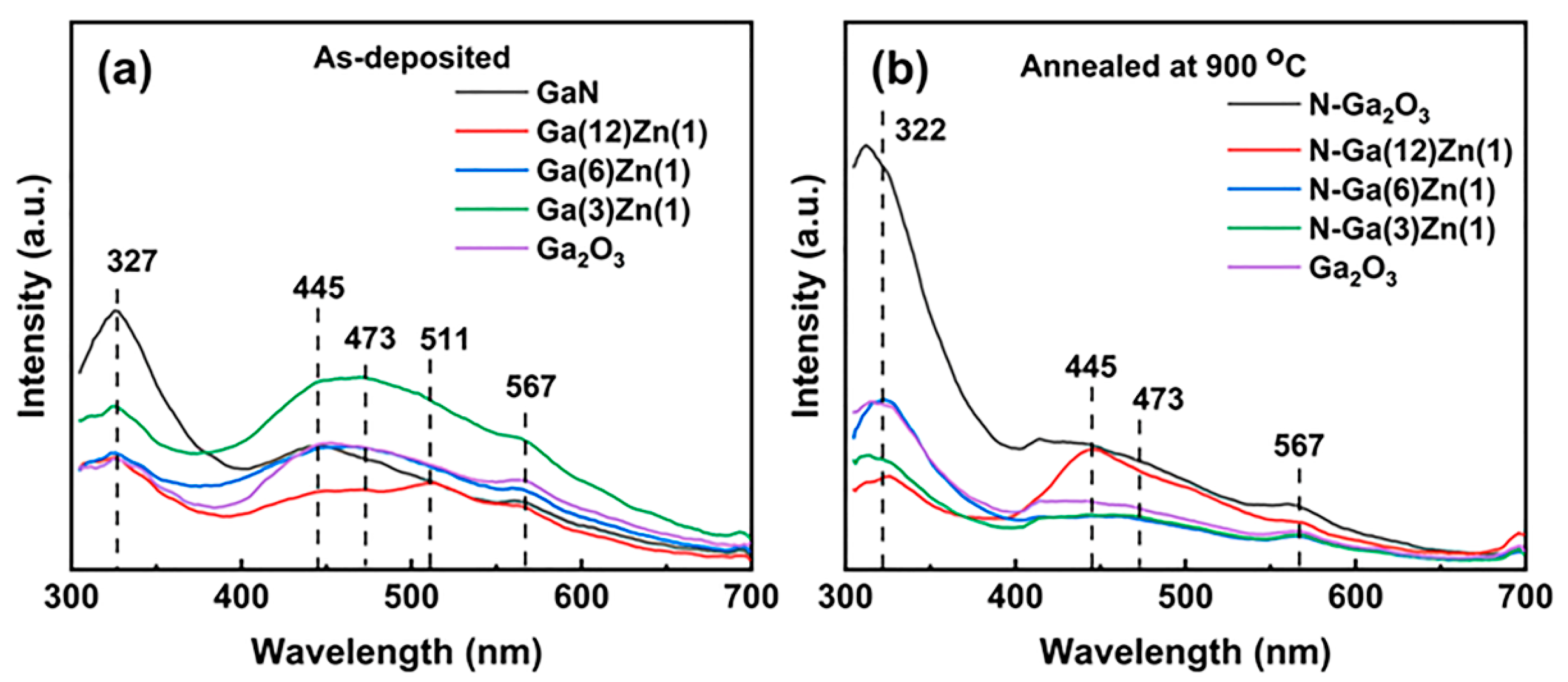Growth of Zn–N Co-Doped Ga2O3 Films by a New Scheme with Enhanced Optical Properties
Abstract
1. Introduction
2. Experimental Procedures
2.1. Sample Preparation
2.2. Characterization
3. Results and Discussion
4. Conclusions
Author Contributions
Funding
Data Availability Statement
Conflicts of Interest
References
- Alema, F.; Seryogin, G.; Osinsky, A.; Osinsky, A. Ge doping of β-Ga2O3 by MOCVD. APL Mater. 2021, 9, 091102. [Google Scholar] [CrossRef]
- Chen, Y.C.; Yang, X.; Zhang, C.Y.; He, G.H.; Chen, X.X.; Qiao, Q.; Zang, J.H.; Dou, W.J.; Sun, P.X.; Deng, Y.; et al. Ga2O3-Based Solar-Blind Position-Sensitive Detector for Noncontact Measurement and Optoelectronic Demodulation. Nano Lett. 2022, 22, 4888–4896. [Google Scholar] [CrossRef] [PubMed]
- Lyle, L.A.M.; Back, T.C.; Bowers, C.T.; Green, A.J.; Chabak, K.D.; Dorsey, D.L.; Heller, E.R.; Porter, L.M. Electrical and chemical analysis of Ti/Au contacts to β-Ga2O3. APL Mater. 2021, 9, 061104. [Google Scholar] [CrossRef]
- Li, L.; Li, C.; Wang, S.; Lu, Q.; Jia, Y.; Chen, H. Preparation of Sn-doped Ga2O3 thin films and their solar-blind photoelectric detection performance. J. Semicond. 2023, 44, 062805. [Google Scholar] [CrossRef]
- Yan, S.; Yang, G.; He, H.; Liu, Q.; Peng, Q.; Chen, J.; Li, M.; Lu, Y.; He, Y. High-Performance Self-Driven Solar-Blind Ultraviolet Photodetectors Based on HfZrO2/beta-Ga2O3 Heterojunctions. ACS Appl. Mater. Interfaces 2023, 15, 22263–22273. [Google Scholar] [CrossRef]
- Alema, F.; Hertog, B.; Ledyaev, O.; Volovik, D.; Thoma, G.; Miller, R.; Osinsky, A.; Mukhopadhyay, P.; Bakhshi, S.; Ali, H.; et al. Solar blind photodetector based on epitaxial zinc doped Ga2O3 thin film. Phys. Status Solidi A 2017, 214, 1600688. [Google Scholar] [CrossRef]
- Ilhom, S.; Mohammad, A.; Shukla, D.; Grasso, J.; Willis, B.G.; Okyay, A.K.; Biyikli, N. Low-Temperature As-Grown Crystalline β-Ga2O3 Films via Plasma-Enhanced Atomic Layer Deposition. ACS Appl. Mater. Interfaces 2021, 13, 8538–8551. [Google Scholar] [CrossRef] [PubMed]
- Wang, C.L.; Zhang, J.C.; Xu, S.R.; Zhang, C.F.; Feng, Q.; Zhang, Y.C.; Ning, J.; Zhao, S.L.; Zhou, H.; Hao, Y. Progress in state-of-the-art technologies of Ga2O3 devices. J. Phys. D Appl. Phys. 2021, 54, 243001. [Google Scholar] [CrossRef]
- Wang, Y.F.; Su, J.; Lin, Z.H.; Zhang, J.C.; Chang, J.J.; Hao, Y. Recent progress on the effects of impurities and defects on the properties of Ga2O3. J. Mater. Chem. C 2022, 10, 13395–13436. [Google Scholar] [CrossRef]
- Choi, Y.H.; Baik, K.H.; Kim, S.; Kim, J. Photoelectrochemical etching of ultra-wide bandgap β-Ga2O3 semiconductor in phosphoric acid and its optoelectronic device application. Appl. Surf. Sci. 2021, 539, 148130. [Google Scholar] [CrossRef]
- Gupta, C.; Pasayat, S.S. Vertical GaN and Vertical Ga2O3 Power Transistors: Status and Challenges. Phys. Status Solidi A 2022, 219, 2100659. [Google Scholar] [CrossRef]
- Wang, J.; Ji, X.; Qi, S.; Li, Z.; Yan, Z.; Li, M.; Yan, X.; Zhong, A.; Lu, C.; Qi, X.; et al. Regulation of oxygen vacancies in nitrogen-doped Ga2O3 films for high-performance MSM solar-blind UV photodetectors. J. Mater. Chem. C 2023, 11, 6202–6211. [Google Scholar] [CrossRef]
- Kumarbekov, K.K.; Kakimov, A.B.; Karipbayev, Z.T.; Kassymzhanov, M.T.; Brik, M.G.; Ma, C.-g.; Piasecki, M.; Suchikova, Y.; Kemere, M.; Konuhova, M. Temperature-dependent luminescence of europium-doped Ga2O3 ceramics. Opt. Mater. X 2025, 25, 100392. [Google Scholar] [CrossRef]
- Luchechko, A.; Vasyltsiv, V.; Stasiv, V.; Kushlyk, M.; Kostyk, L.; Włodarczyk, D.; Zhydachevskyy, Y. Luminescence spectroscopy of Cr3+ ions in bulk single crystalline β-Ga2O3-In2O3 solid solutions. Opt. Mater. 2024, 151, 115323. [Google Scholar] [CrossRef]
- Alema, F.; Itoh, T.; Vog, S.; Speck, J.S.; Osinsky, A. Highly conductive epitaxial β-Ga2O3 and β-(AlxGa1−x)2O3 films by MOCVD. Jpn. J. Appl. Phys. 2022, 61, 100903. [Google Scholar] [CrossRef]
- Hu, D.Q.; Wang, Y.; Zhuang, S.W.; Dong, X.; Zhang, Y.T.; Yin, J.Z.; Zhang, B.L.; Lv, Y.J.; Feng, Z.H.; Du, G.T. Surface morphology evolution and optoelectronic properties of heteroepitaxial Si-doped β-Ga2O3 thin films grown by metal-organic chemical vapor deposition. Ceram. Int. 2018, 44, 3122–3127. [Google Scholar] [CrossRef]
- Mi, W.; Du, X.J.; Luan, C.N.; Xiao, H.D.; Ma, J. Electrical and optical characterizations of β-Ga2O3: Sn films deposited on MgO(110) substrate by MOCVD. RSC Adv. 2014, 4, 30579–30583. [Google Scholar] [CrossRef]
- Zhang, X.Y.; Yang, Y.; Fan, W.H.; Wang, C.; Wu, W.Y.; Tseng, M.C.; Wuu, D.S.; Gao, P.; Kuo, H.C.; Lien, S.Y.; et al. Growth and characterization of Si-doped Ga2O3 thin films by remote plasma atomic layer deposition: Toward UVC-LED application. Surf. Coat. Technol. 2022, 435, 128252. [Google Scholar] [CrossRef]
- Tao, J.J.; Lu, H.L.; Gu, Y.; Ma, H.P.; Li, X.; Chen, J.X.; Liu, W.J.; Zhang, H.; Feng, J.J. Investigation of growth characteristics, compositions, and properties of atomic layer deposited amorphous Zn-doped Ga2O3 films. Appl. Surf. Sci. 2019, 476, 733–740. [Google Scholar] [CrossRef]
- Galazka, Z.; Ganschow, S.; Fiedler, A.; Bertram, R.; Klimm, D.; Irmscher, K.; Schewski, R.; Pietsch, M.; Albrecht, M.; Bickermann, M. Doping of Czochralski-grown bulk β-Ga2O3 single crystals with Cr, Ce and Al. J. Cryst. Growth 2018, 486, 82–90. [Google Scholar] [CrossRef]
- Feng, Q.J.; Liu, J.Y.; Yang, Y.Q.; Pan, D.Z.; Xing, Y.; Shi, X.C.; Xia, X.C.; Liang, H.W. Catalytic growth and characterization of single crystalline Zn doped p-type β-Ga2O3 nanowires. J. Alloys Compd. 2016, 687, 964–968. [Google Scholar] [CrossRef]
- Yan, C.Y.; Su, J.; Wang, Y.F.; Lin, Z.H.; Zhang, J.C.; Chang, J.J.; Hao, Y. Reducing the acceptor levels of p-type β-Ga2O3 by (metal, N) co-doping approach. J. Alloys Compd. 2021, 854, 157247. [Google Scholar] [CrossRef]
- Su, Y.L.; Guo, D.Y.; Ye, J.H.; Zhao, H.L.; Wang, Z.; Wang, S.L.; Li, P.G.; Tang, W.H. Deep level acceptors of Zn-Mg divalent ions dopants in β-Ga2O3 for the difficulty to p-type conductivity. J. Alloys Compd. 2019, 782, 299–303. [Google Scholar] [CrossRef]
- Jiang, Z.X.; Wu, Z.Y.; Ma, C.C.; Deng, J.N.; Zhang, H.; Xu, Y.; Ye, J.D.; Fang, Z.L.; Zhang, G.Q.; Kang, J.Y.; et al. P-type β-Ga2O3 metal-semiconductor-metal solar-blind photodetectors with extremely high responsivity and gain-bandwidth product. Mater. Today Phys. 2020, 14, 100226. [Google Scholar] [CrossRef]
- Wu, Z.Y.; Jiang, Z.X.; Ma, C.C.; Ruan, W.; Chen, Y.; Zhang, H.; Zhang, G.Q.; Fang, Z.L.; Kang, J.Y.; Zhang, T.Y. Energy-driven multi-step structural phase transition mechanism to achieve high-quality p-type nitrogen-doped β-Ga2O3 films. Mater. Today Phys. 2021, 17, 100356. [Google Scholar] [CrossRef]
- Ardenghi, A.; Bierwagen, O.; Falkenstein, A.; Hoffmann, G.; Lähnemann, J.; Martin, M.; Mazzolini, P. Toward controllable Si-doping in oxide molecular beam epitaxy using a solid SiO source: Application to β-Ga2O3. Appl. Phys. Lett. 2022, 121, 042109. [Google Scholar] [CrossRef]
- Azizie, K.; Hensling, F.V.E.; Gorsak, C.A.; Kim, Y.; Pieczulewski, N.A.; Dryden, D.M.; Senevirathna, M.K.I.; Coye, S.; Shang, S.-L.; Steele, J.; et al. Silicon-doped β-Ga2O3 films grown at 1 µm/h by suboxide molecular-beam epitaxy. APL Mater. 2023, 11, 041102. [Google Scholar] [CrossRef]
- Wang, C.; Li, S.W.; Fan, W.H.; Zhang, Y.C.; Lin, H.J.; Zhang, X.Y.; Lien, S.Y.; Zhu, W.Z.; Wuu, D.S. Annealing temperature controlled crystallization mechanism and properties of gallium oxide film in forming gas atmosphere. J. Am. Ceram. Soc. 2022, 105, 4487–4499. [Google Scholar] [CrossRef]
- Zhang, J.; Wang, W.; Wu, S.; Geng, Z.; Zhang, J.; Chen, L.; Liu, N.; Yan, X.; Zhang, W.; Ye, J. Exploratory phase stabilization in heteroepitaxial gallium oxide films by pulsed laser deposition. J. Alloys Compd. 2023, 935, 168123. [Google Scholar] [CrossRef]
- Zhang, T.; Li, Y.; Cheng, Q.; Hu, Z.; Ma, J.; Yao, Y.; Zuo, Y.; Feng, Q.; Zhang, Y.; Zhou, H.; et al. Influence of O2 pulse on the β-Ga2O3 films deposited by pulsed MOCVD. Ceram. Int. 2022, 48, 8268–8275. [Google Scholar] [CrossRef]
- Borujeny, E.R.; Sendetskyi, O.; Fleischauer, M.D.; Cadien, K.C. Low Thermal Budget Heteroepitaxial Gallium Oxide Thin Films Enabled by Atomic Layer Deposition. ACS Appl. Mater. Interfaces 2020, 12, 44225–44237. [Google Scholar] [CrossRef] [PubMed]
- Liu, X.T.; Wang, S.Q.; He, L.; Jia, Y.F.; Lu, Q.; Chen, H.F.; Ma, F.; Hao, Y. Growth characteristics and properties of Ga2O3 films fabricated by atomic layer deposition technique. J. Mater. Chem. C 2022, 10, 16247–16264. [Google Scholar] [CrossRef]
- Zhang, L.Y.; Yan, J.L.; Zhang, Y.J.; Li, T.; Ding, X.W. A comparison of electronic structure and optical properties between N-doped β-Ga2O3 and N-Zn co-doped β-Ga2O3. Phys. B 2012, 407, 1227–1231. [Google Scholar] [CrossRef]
- Allen, T.G.; Cuevas, A. Plasma enhanced atomic layer deposition of gallium oxide on crystalline silicon: Demonstration of surface passivation and negative interfacial charge. Phys. Status Solidi–Rapid Res. Lett. 2015, 9, 220–224. [Google Scholar] [CrossRef]
- Kumar, M.; Poulose, A.C.; Nakajima, Y.; Sakthikumar, D.; Kumar, V.; Singh, R. Anomalous emission from oxygen incorporated GaN nanowires. Phys. E 2018, 104, 187–191. [Google Scholar] [CrossRef]
- Saw, K.G.; Aznan, N.M.; Yam, F.K.; Ng, S.S.; Pung, S.Y. New Insights on the Burstein-Moss Shift and Band Gap Narrowing in Indium-Doped Zinc Oxide Thin Films. PLoS ONE 2015, 10, 0141180. [Google Scholar] [CrossRef]
- Cooke, J.; Ghadbeigi, L.; Sun, R.J.; Bhattacharyya, A.; Wang, Y.H.; Scarpulla, M.A.; Krishnamoorthy, S.; Sensale-Rodriguez, B. Synthesis and Characterization of Large-Area Nanometer-Thin β-Ga2O3 Films from Oxide Printing of Liquid Metal Gallium. Phys. Status Solidi A 2020, 217, 1901007. [Google Scholar] [CrossRef]
- Liu, H.; Xu, C.X.; Pan, X.H.; Ye, Z.Z. The Photoluminescence Properties of β-Ga2O3 Thin Films. J. Electron. Mater. 2020, 49, 4544–4549. [Google Scholar] [CrossRef]
- Ogugua, S.N.; Swart, H.C.; Ntwaeaborwa, O.M. Effects of deposition environment and temperature on photoluminescence, particle morphology, and crystal structure of pulsed laser deposited Ga2O3 thin films. J. Vac. Sci. Technol. A 2020, 38, 043407. [Google Scholar] [CrossRef]
- Shi, Q.; Wang, Q.R.; Zhang, D.; Wang, Q.L.; Li, S.H.; Wang, W.J.; Fan, Q.L.; Zhang, J.Y. Structural, optical and photoluminescence properties of Ga2O3 thin films deposited by vacuum thermal evaporation. J. Lumin. 2019, 206, 53–58. [Google Scholar] [CrossRef]
- Zhang, T.; Li, Y.; Zhang, Y.; Feng, Q.; Ning, J.; Zhang, C.; Zhang, J.; Hao, Y. Effect of Temperature on the Structural and Optical Properties of Ga2O3 Thin Films Grown on m-plane Sapphire Substrates by Low-Pressure MOCVD. ECS J. Solid. State Sci. Technol. 2020, 9, 065009. [Google Scholar] [CrossRef]
- Mi, W.; Luan, C.N.; Li, Z.; Zhao, C.S.; Feng, X.J.; Ma, J. Ultraviolet-green photoluminescence of β-Ga2O3 films deposited on MgAl6O10 (100) substrate. Opt. Mater. 2013, 35, 2624–2628. [Google Scholar] [CrossRef]
- Yue, W.; Yan, J.; Wu, J.; Zhang, L. Structural and optical properties of Zn-doped β-Ga2O3 films. J. Semicond. 2012, 33, 073003. [Google Scholar] [CrossRef]
- Li, W.H.; Peng, Y.K.; Wang, C.; Zhao, X.L.; Zhi, Y.S.; Yan, H.; Li, L.H.; Li, P.G.; Yang, H.J.; Wu, Z.P.; et al. Structural, optical and photoluminescence properties of Pr-doped β-Ga2O3 thin films. J. Alloys Compd. 2017, 697, 388–391. [Google Scholar] [CrossRef]






| Sample | Growth Cycles of GaN | Growth Cycles of ZnO | Number of Supercycle | Growth Cycles of Ga2O3 |
|---|---|---|---|---|
| GaN | 500 | 0 | / | / |
| Ga:Zn = 12:1 | 468 | 39 | 39 (12GaN + 1ZnO) | / |
| Ga:Zn = 6:1 | 450 | 75 | 75 (6GaN + 1ZnO) | / |
| Ga:Zn = 3:1 | 375 | 125 | 125 (3GaN + 1ZnO) | / |
| Ga2O3 | / | / | / | 500 |
Disclaimer/Publisher’s Note: The statements, opinions and data contained in all publications are solely those of the individual author(s) and contributor(s) and not of MDPI and/or the editor(s). MDPI and/or the editor(s) disclaim responsibility for any injury to people or property resulting from any ideas, methods, instructions or products referred to in the content. |
© 2025 by the authors. Licensee MDPI, Basel, Switzerland. This article is an open access article distributed under the terms and conditions of the Creative Commons Attribution (CC BY) license (https://creativecommons.org/licenses/by/4.0/).
Share and Cite
Liao, D.; Zhang, Y.; Wang, R.; Yan, T.; Li, C.; Tian, H.; Wang, H.; Ye, Z.-G.; Ren, W.; Niu, G. Growth of Zn–N Co-Doped Ga2O3 Films by a New Scheme with Enhanced Optical Properties. Nanomaterials 2025, 15, 1020. https://doi.org/10.3390/nano15131020
Liao D, Zhang Y, Wang R, Yan T, Li C, Tian H, Wang H, Ye Z-G, Ren W, Niu G. Growth of Zn–N Co-Doped Ga2O3 Films by a New Scheme with Enhanced Optical Properties. Nanomaterials. 2025; 15(13):1020. https://doi.org/10.3390/nano15131020
Chicago/Turabian StyleLiao, Daogui, Yijun Zhang, Ruikang Wang, Tianyi Yan, Chao Li, He Tian, Hong Wang, Zuo-Guang Ye, Wei Ren, and Gang Niu. 2025. "Growth of Zn–N Co-Doped Ga2O3 Films by a New Scheme with Enhanced Optical Properties" Nanomaterials 15, no. 13: 1020. https://doi.org/10.3390/nano15131020
APA StyleLiao, D., Zhang, Y., Wang, R., Yan, T., Li, C., Tian, H., Wang, H., Ye, Z.-G., Ren, W., & Niu, G. (2025). Growth of Zn–N Co-Doped Ga2O3 Films by a New Scheme with Enhanced Optical Properties. Nanomaterials, 15(13), 1020. https://doi.org/10.3390/nano15131020







